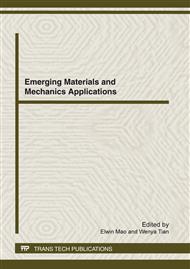[1]
Khramtsov V V, Grigor'Ev I A, Foster M A, et al. Biological applications of spin pH probes[J]. Cell Mol. Biol., 2000, 46 (8): 1361-1374.
Google Scholar
[2]
Sun K M, Mclaughlin CK, Lantero D R, et al. Biomarkers for Phenol Carcinogen Exposure Act as pH-Sensing Fluorescent Probes[J]. J. Am. Chem. Soc., 2007, 129(7): 1894-1895.
DOI: 10.1021/ja068416l
Google Scholar
[3]
Noroozifar M, Motagh M K, Bahmanzadeh S, et al. A novel optical membrane with extended detection range of pH[J]. Turk J. Chem., 2010, 34: 719-730.
Google Scholar
[4]
Fuh M R S, Burgess L W, Hirschfeld T, et al. Single fibre optic fluorescence pH probe[J]. Analyst, 1987, 112(8): 1159-1163.
DOI: 10.1039/an9871201159
Google Scholar
[5]
Safavi A, Abdollahi H. Optical sensor for high pH values[J]. Anal. Chim. Acta., 1998, 367: 167-173.
DOI: 10.1016/s0003-2670(98)00079-8
Google Scholar
[6]
Lin J, Liu D. An optical pH sensor with a linear response over a broad range[J]. Anal. Chim. Acta., 2000, 408: 49-55.
DOI: 10.1016/s0003-2670(99)00840-5
Google Scholar
[7]
Ulrich G, Ziessel R, Harriman A. The Chemistry of fluorescent bodipy dyes: versatility unsurpassed[J]. Angew. Chem. Int. Ed., 2008, 47: 1184-1201.
DOI: 10.1002/anie.200702070
Google Scholar
[8]
Guliyev R, Coskun A, Akkaya E U. Design strategies for ratiometric chemosensors: modulation of excitation energy transfer at the energy donor site[J]. J. Am. Chem. Soc., 2009, 131(5): 9007-9013.
DOI: 10.1021/ja902584a
Google Scholar
[9]
Yuan M , Zhou W , Liu X , et al. A multianalyte chemosensor on a single molecule: promising structure for an integrated logic gate[J]. J. Org. Chem., 2008, 73(13): 5008-5014.
DOI: 10.1021/jo8005683
Google Scholar
[10]
Ekmekci Z, Yilmaz M D, Akkaya E U. A monostyryl-boradiazaindacene (BODIPY) derivative as colorimetric and fluorescent probe for cyanide ions[J]. Org. Lett., 2008, 10(3): 461-464.
DOI: 10.1021/ol702823u
Google Scholar
[11]
Baruah M, Qin W, Basaric N, et al. BODIPY-based hydroxyaryl derivatives as fluorescent pH probes[J]. J. Org. Chem., 2005, 70 (10): 4152-4157.
DOI: 10.1021/jo0503714
Google Scholar
[12]
Liu Y, Liu S, Wang Y. Highly sensitive acidic pH fluorescent probe based on a boradiaza-indacene derivative[J]. Chem. Res. Chin, U., 2010, 26(2): 249-251.
Google Scholar
[13]
Xu H Y, Shen Z. Fluorescent probe for H+: synthesis, spectroscopic and electrochemical studies of exocyclic ring-fused boron dipyrromethene dyes[J]. Chin. J. Inorg. Chem., 2011, 27(6): 1177-1784.
Google Scholar
[14]
Xu Yunhai, Lai Lanmei, Liu Ying. Research on Cyclohexene Prepared by Cyclohexanol under the Mixed Acid Catalysis[J]. Applied Chemical Industry, 2010, 39(11): 1673-1675.
Google Scholar
[15]
Hartman G D, Weinstock L M. Thiazoles from ethyl isocyanoacetate and thiono esters: ethyl thiazole - 4- carboxylate[J]. Org. Synth., 1979, 59: 183-189.
DOI: 10.15227/orgsyn.059.0183
Google Scholar
[16]
Kollmanmberger M, Ruraek K, Resch-Genger U, et a1. Ultrafast charge transfer in amino -substituted boron dipyrromethene dyes and its inhibition by cation complexation: A new design concept for highly sensitive fluorescent probes[J]. J. Phys. Chem. A., 1998, 102(50): 10211-10220.
DOI: 10.1021/jp982701c
Google Scholar
[17]
On N, Kawamura H, Bougauchi M, et al. Porphyrin synthesis from nirocompounds[J]. Tetrahedron, 1990, 46(21): 7483-7496.
DOI: 10.1016/s0040-4020(01)89062-1
Google Scholar
[18]
Corey E J, Estreicher H. A new synthesis of conjugated nitro cyclo olefins, unusually versatile synthetic intermediates[J]. J. Am. Chem. Soc., 1978, 100(19): 6294-6295.
DOI: 10.1021/ja00487a088
Google Scholar
[19]
Maus M, Rurack K. Monitoring pH and solvent proticity with donor-acceptor-substituted biphenyls: a new approach towards highly sensitive and powerful fluorescent probes by tuning the molecular structure[J]. New. J. Chem., 2000, 24: 677-686.
DOI: 10.1039/b003819i
Google Scholar
[20]
Beer G., Rurack K. Chiral discrimination with a fluorescent boron-dipyrromethene dye[J]. Chem. Commun., 2001, 1138-1139.
DOI: 10.1039/b102376b
Google Scholar


